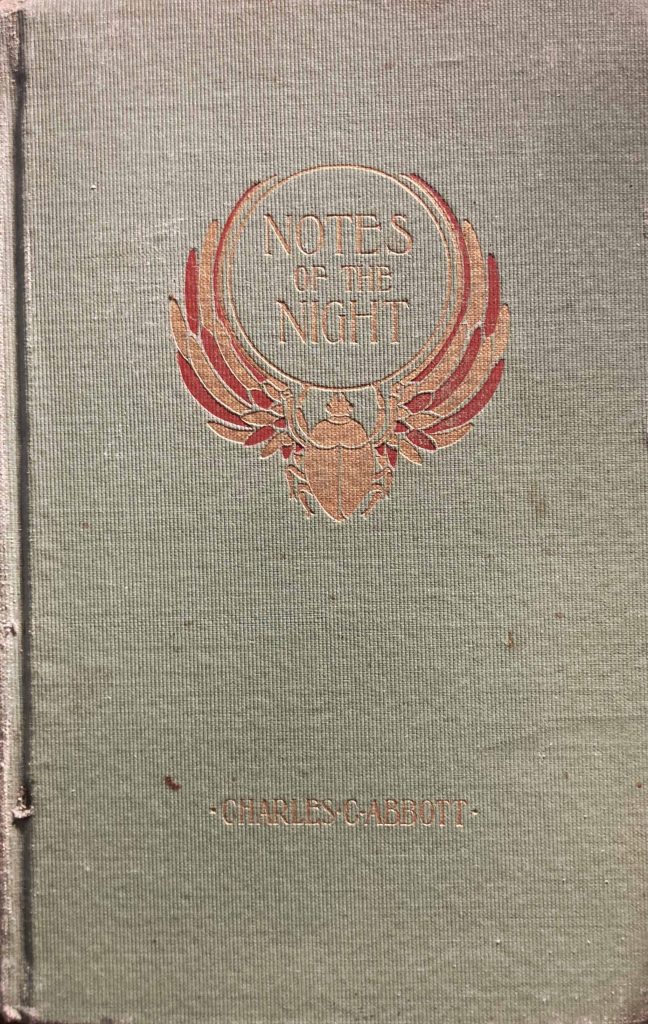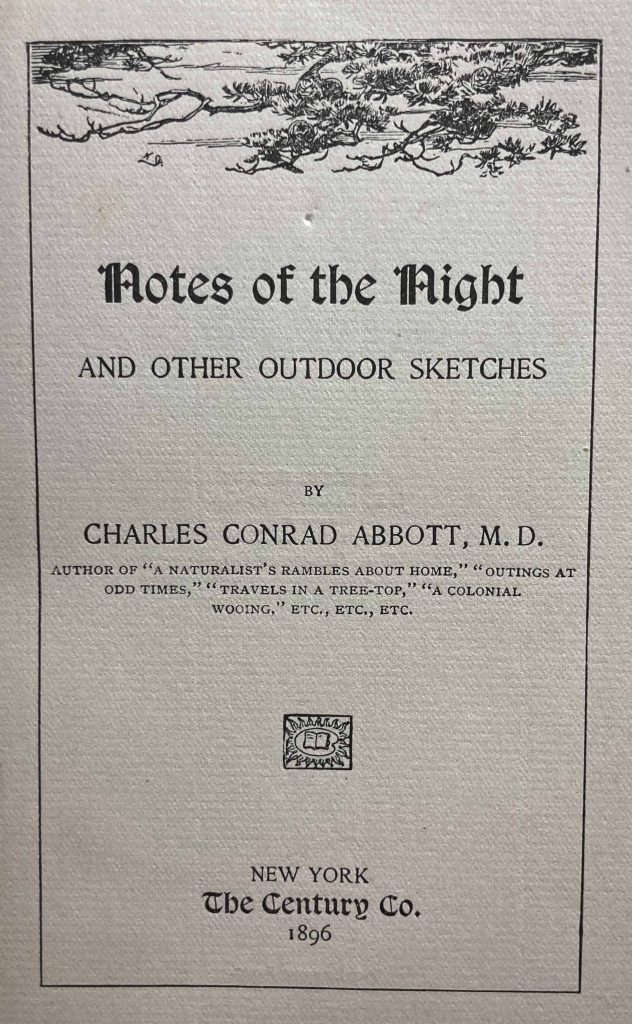

Though you may have been familiar with the locality by day for all of your life, it is another world now. Go out into the night with no disturbing thoughts. Gaze awhile at the stars and lose in a measure your earthiness, and a song of a dreaming bird will arouse you to a quicker sympathy with the creatures to which it is now day.
I return again to the indomitable and highly prolific author Charles Conrad Abbott, M.D. (1843-1919). Again I wend my way through the thickets of his prose, hoping to glean a few literary morsels like the lovely bit above to record in my notebook and share with my readers. It is slow going. Abbott is not easy on the reader. He rambles interminably, and his sentences, while not quite labyrinthine, rarely capture my attention. As a resident of the Trenton area, the flora and fauna he describes are quite similar to that of my own native home in Horsham, Pennsylvania. The Delaware River at his doorstep runs through my own childhood by way of canoe trips (well upstream) and many visits to its banks. His interest in the past — both prehistory and colonial days — mirrors my own. And yet I struggle to keep moving forward. The challenge, I think, lies in his tendency toward prolix description. Nothing happens. Rarely does he lead you from his doorstep, out into the meadows and woods around his home, then back again. In the moments when he offers a narrative thread to bind his observations and thoughts together, the result almost works. Abbott is capable of applying an endearing humorous tone to his prose, though he does that all too rarely.
My favorite part of the book is set in the brutal heat and humidity of midsummer in the Delaware Valley. I will quote it in full if only for my own future enjoyment looking back through these past posts:
Liquify brass by heat and then reduce the liquid to a yellow gas, and you will have what did duty for atmosphere at high noon recently. It was 95o in the shade, on the north porch, and away above 100o out in the fields. For this reason, I took to the fields, and finding only crickets equal to the occasion, kept on, and soon plunged into a ferny thicket with three big oaks and a bubbling spring. Here the thermometer showed but 88o, so I had found a cool spot and concluded to tarry. It was all very well to let enthusiasm suggest examining the animal life of a field at noon, but to carry out such suggestions does not pay for the danger involved. It was hot enough to melt your brain, and I shall never forget the languid look of one poor toad that by some cause had been ousted from his day-time retreat and found it too hot to go hunt up another. That toad would not hop, but let me roll him over with the toe of my shoe. The rattling creak of the crickets sounded precisely like the crisp crackling of dry twigs in a fire. What is to be known of open fields at mid-day in summer, let others tell me.
The scene continues with Abbott remaining in the shade by the spring, watching the birds. Eventually, he disturbs a cloud of mosquitoes which drives him back out into the sun-baked field. After a few moments of contemplating the absurdity of being forced out of a relatively pleasant retreat and back into the hot sun, he screws up his courage and returns to the spring and the calling birds. This time, the mosquitoes stay away. It may not be the makings of a movie or even a short story, but it is the closest to high drama that Abbott allows himself to get.
As I read through the book, I did extract some odds and ends of interest. With regard to the literary influences on Abbott, Thoreau is undoubtedly first. Abbott references Thoreau several times and ends his book with a brief and rather lackluster essay on him. The only other writer mentioned, interestingly enough, is John Muir; in his first essay, Abbott remarks that “I had been reading that day Muir’s volume, and the mountains of California seem to have settled over the Jersey meadows.” Another aspect of the book that I appreciated was that Abbott approached nature without fear, urging others to do the same. While recognizing that people tend to have an innate fear of being outdoors at night, Abbott encouraged his readers to overcome that fear and explore the “night country” (as Loren Eisley would later call it). In a later essay in which Abbott dedicated several pages to local reptiles, he remarked on how “utterly unreasonable it is to be afraid of snakes.” Indeed, he urged readers to get out into nature and observe animals with an open mind, letting go of preconceptions and seeking to know the purpose that animal serves in nature. Of course, this outlook did not preclude him from determining the whereabouts of a snapping turtle’s nest and gathering all the eggs to eat.
Finally, throughout the book are passages that speak to the human impacts on nature at the time. For the most part, Abbott seems to recognize that humans have been rather destructive to their environment, yet he generally stops short of advocating a solution. At one point, he observes that “the stream that has a factory on its banks too often has nothing in its waters.” Elsewhere, he notes that “we are doing so little to preserve what remains of our forests.” In yet another essay, Abbott complains about the dwindling number of bluebirds in New Jersey due to egg collectors and invasive sparrows. Here, he goes so far as to call for more protective laws to safeguard songbird numbers. In another passage, he acknowledges human impacts on natural systems, observing that “We should remember that the so-called balance of nature is necessarily disturbed by men’s interference.” Yet he is not willing to discard the possibility that humans have been a positive influence on some species. In particular, thanks to humans, many small birds have more nesting sites and an abundant food supply. This argument has been noted in the writings of others at this time and appears to have been a general belief. Of course, this was also a time in which many Americans were convinced that “rain follows the plow.”